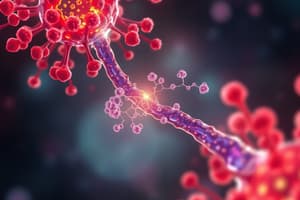Podcast
Questions and Answers
Which molecule is responsible for transporting peptides across the endoplasmic reticulum in antigen processing?
Which molecule is responsible for transporting peptides across the endoplasmic reticulum in antigen processing?
- Proteasome
- Calnexin
- Invariant Chain
- TAP Transporter (correct)
What is the primary function of the proteasome in antigen processing?
What is the primary function of the proteasome in antigen processing?
- Binding peptides to MHC class I molecules
- Stabilizing MHC class II molecules
- Degrading cytosolic proteins into peptides (correct)
- Transporting peptides across the ER
What is the role of the invariant chain (Ii) in MHC class II processing?
What is the role of the invariant chain (Ii) in MHC class II processing?
- To assist in peptide binding
- To prevent premature peptide binding in the ER (correct)
- To transport peptides to the ER
- To trim peptides to the correct length
Which component serves as a chaperone protein for MHC class I molecules in the ER?
Which component serves as a chaperone protein for MHC class I molecules in the ER?
Which pathway processes intracellular antigens and is associated with MHC class I?
Which pathway processes intracellular antigens and is associated with MHC class I?
What role does ERAAP play in antigen processing?
What role does ERAAP play in antigen processing?
Which of the following correctly describes MHC class II processing?
Which of the following correctly describes MHC class II processing?
Which component links MHC class I molecules to the TAP during peptide loading?
Which component links MHC class I molecules to the TAP during peptide loading?
Flashcards
Proteasome
Proteasome
A large, multicatalytic protease complex responsible for degrading proteins within the cytosol. It is composed of approximately 28 subunits.
TAP Transporter (Transporter Associated with Antigen Processing)
TAP Transporter (Transporter Associated with Antigen Processing)
A heterodimer composed of TAP-1 and TAP-2 proteins that transports peptides across the endoplasmic reticulum (ER). It plays a crucial role in the MHC Class I antigen processing pathway.
Calnexin
Calnexin
An ER membrane-bound chaperone protein that binds to MHC Class I molecules until a peptide is loaded onto it. This ensures that only peptide-loaded MHC Class I molecules are transported to the cell surface.
Peptide Loading Complex (PLC)
Peptide Loading Complex (PLC)
Signup and view all the flashcards
ERAAP (Endoplasmic Reticulum Aminopeptidase associated with Antigen Processing)
ERAAP (Endoplasmic Reticulum Aminopeptidase associated with Antigen Processing)
Signup and view all the flashcards
Invariant Chain (Ii, CD74)
Invariant Chain (Ii, CD74)
Signup and view all the flashcards
Endogenous Pathway
Endogenous Pathway
Signup and view all the flashcards
Exogenous Pathway
Exogenous Pathway
Signup and view all the flashcards
Study Notes
Antigen Processing and Presentation
-
Antigen processing involves two main pathways: MHC class I and MHC class II
-
The endogenous pathway (MHC class I): processes intracellular antigens
- Intracellular proteins are degraded into peptides by the proteasome.
- Peptides are transported into the endoplasmic reticulum via TAP.
- Peptides bind to MHC class I molecules.
- MHC class I-peptide complexes are presented on the cell surface to CD8+ T cells.
-
The exogenous pathway (MHC class II): processes extracellular antigens
- Extracellular antigens are taken up by endocytosis, forming endosomes or lysosomes.
- Antigens are degraded to peptides.
- Peptides bind to MHC class II molecules.
- MHC class II-peptide complexes are presented on the cell surface to CD4+ T cells.
Processing "Machinery"
- Proteasome: A large, multicatalytic protease complex (~28 subunits) that degrades cytosolic proteins.
- TAP Transporter (transporter associated with antigen processing): A heterodimer of TAP-1 and TAP-2 proteins.
- Transports peptides across the endoplasmic reticulum (ER).
- Calnexin: An ER membrane-bound protein (88 kDa) that retains MHC class I molecules in the ER until the peptide is bound. It acts as a chaperone protein.
- Peptide Loading Complex (PLC): A complex of chaperone proteins
- Calreticulin: Similar function to calnexin
- Tapasin: Links MHC Class I to TAP.
- ERp57: Mediates peptide binding to Class I.
- Endoplasmic Reticulum Aminopeptidase associated with Antigen Processing (ERAAP): Trims peptides to the correct length.
Invariant Chain (Ii, CD74)
- Associates with newly formed MHC class II molecules to prevent peptide binding in the ER.
- Targets delivery of new Class II molecules to low pH endosomes.
Antigen Processing with Class I
- Partly folded MHC class I α chains bind to calnexin until β2-microglobulin binds.
- MHC class I α:β2m complex is released from calnexin.
- Binds a complex of chaperone proteins (calreticulin, ERp57) and TAP via tapasin.
- Cytosolic proteins (and defective ribosomal products) are degraded to peptide fragments by the proteasome.
- TAP delivers peptides to the ER.
- A peptide binds MHC class I molecule and completes its folding.
- The MHC class I molecule is released from the TAP complex and exported to the cell membrane.
- Normal proteins (>70%) vs. DRIPs (<30%).
Antigen Processing with Class II
- Invariant chain (li, CD74) forms a complex with MHC class II molecules blocking peptide binding and misfolded protein binding.
- li is cleaved in an acidified endosome; leaving a short peptide fragment (CLIP) still bound to MHC class II.
- Endocytosed antigens are degraded to peptides in endosomes; CLIP blocks antigen binding to MHC II.
- HLA-DM binds to MHC II molecule, releasing CLIP, allowing other peptides to bind.
- MHC II molecule travels to the cell surface.
Studying That Suits You
Use AI to generate personalized quizzes and flashcards to suit your learning preferences.




